He thought that number high. "I never see them, and I see everything - deer, coyotes, bobcats, foxes, skunks, raccoons..." "And people I talk to never see them, and you have remote cam traps up there and never post photos of them."
"Yah, but..." I do get them.
It's the Santa Cruz Mountains of California. Running from San Fran to Gilroy, it's 75 miles long and 1,400 miles square of rural and remote oak woodlands and redwood forests, chaparral, rolling hills, riparian corridors, lakes, ponds, and rocky ridges with 2,000-4,000-foot peaks.
And there are deer. LOTS of deer.
So, of course there are lions. They're out there doing their job - roaming their huge home ranges, keeping the deer on the move, whacking the weak, and avoiding us at all costs. You have to love an apex predator with those values.
I just generally don't write about them because I worry they'll get too sensationalized. But perhaps it's better if they are seen more often. Maybe it'll help people understand that they really are around, and they really aren't a threat.
So, in that vein, here's a Santa Cruz Mountains lion story for you. It's about a cougar mom and her cub that I've been sporadically catching on cams for about 8 months.
One of the earliest photo series was a bit in your face, as the mom decided to give the cam trap a serious up-close inspection:

Great "what the heck?" look, huh? She obviously wasn't expecting the camera to wake up. The surprise is probably more from the "whirring" noise than the ensuing flash.
Note the nose dots, ear notches, whisker pattern, high cheekbones and skinny tail. All are features we use to ID the mom and differentiate other lions. In the full high-res, of course.
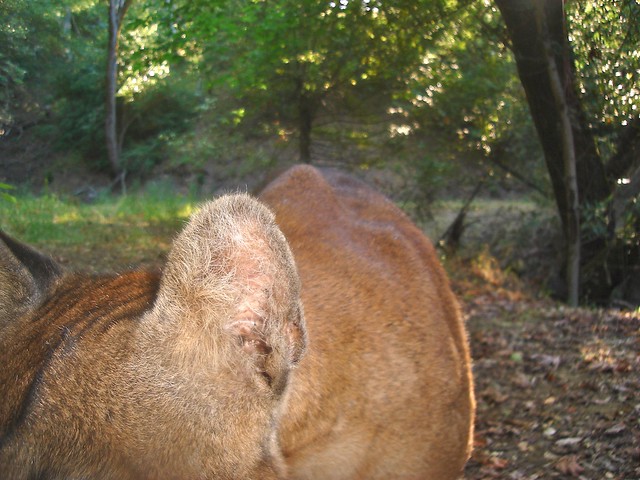
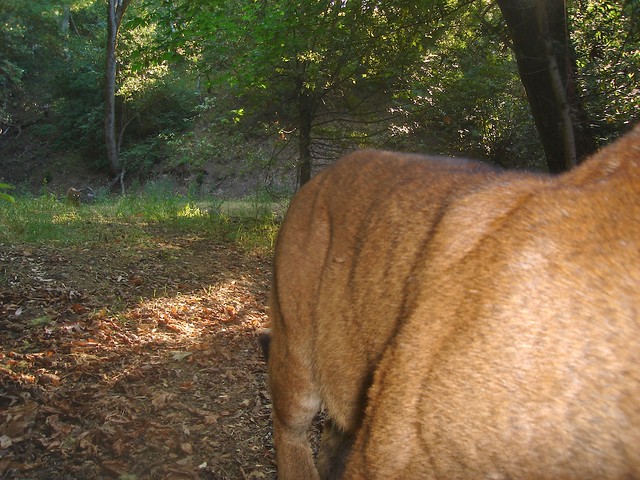
As mom was checking the cam, her cub was hanging back, even lying down to wait before following. You can see the shine of the cub's eyes in the photos above and below. The trailing distance might be to facilitate hunting. Allows mom to slink well ahead of inexperienced youngins.
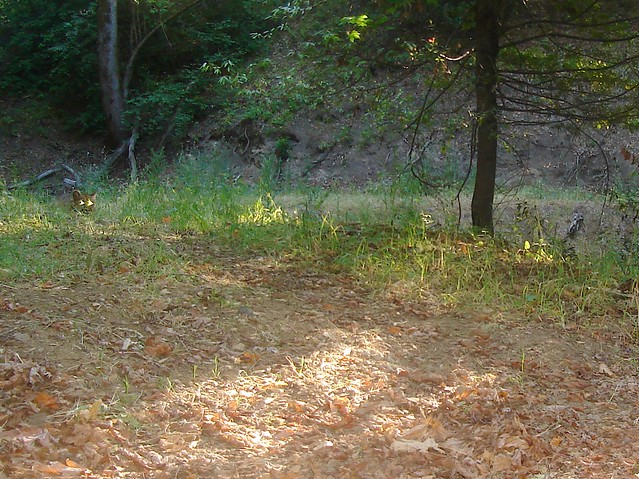
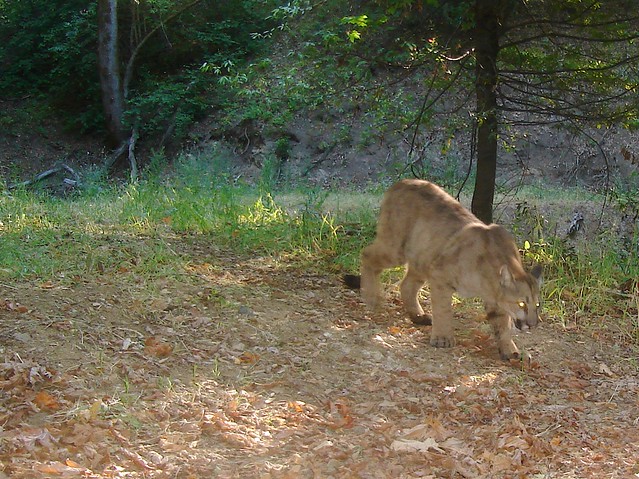
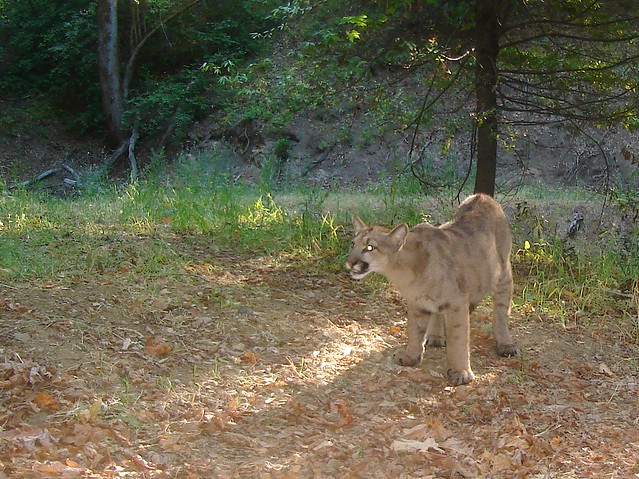
Such paws. And still somewhat spotty and fluffy. Taken 6 months ago, I think the cub is about 10 months old in these photos.
You may have noticed the mom looked a bit bony, with hollow cheeks. We're pretty sure from other photos that she originally had 2 cubs, and lost one about this time. Potentially a young mother, the toll of raising 2 cubs may have been tough on her health-wise. Once cubs get to size, it can take a deer kill every few days to support them.
We don't know what happened to the other cub, though. Perhaps hit by a car, or killed by a territorial male. But it's not likely the mom harmed the cub. Not their style once cubs reach such an age. Too much invested.
===
Round 2
A couple months later, in summer, the cougar mom and cub passed another cam:
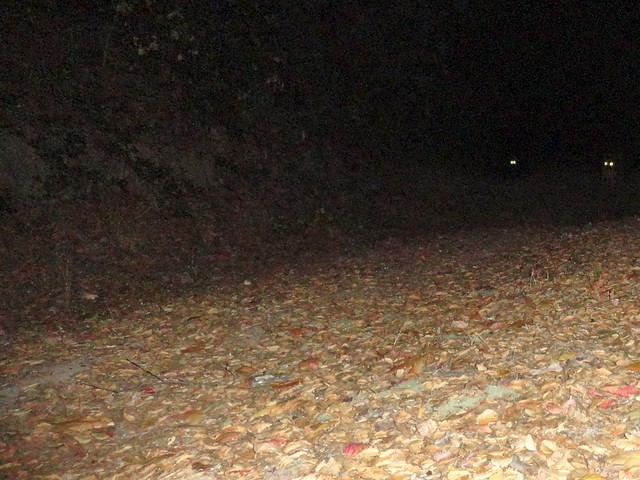
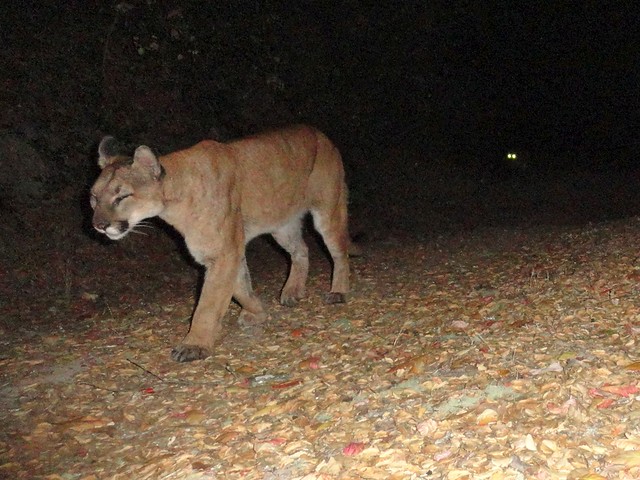
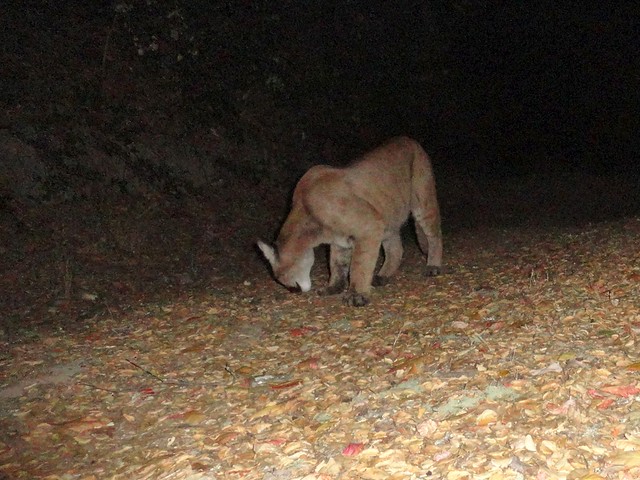
The mom was looking much healthier by then. And the cub bigger and almost spotless.
At this location there were actually 2 remote cams side-by-side, with one set to record video. And while it only grabbed 10 seconds, and didn't last long enough to fully get the cub, it's fun to see how smoothly the mom slinks by. And is completely unfazed when the other cam flashes and catches the above still photo of her squinting. :)
==
Round 3
Just a few weeks ago, the mom and cub spent some more quality time in front of a camera. This time my super-fast Reconyx, leaving a total of 83 images of interesting behavior.
On the first visit only the mom passed the camera:
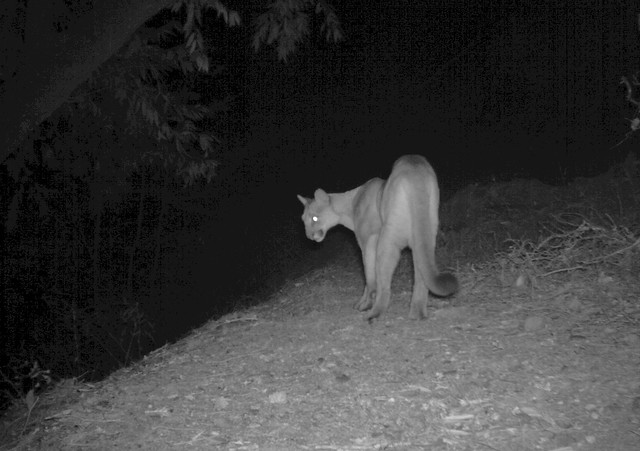
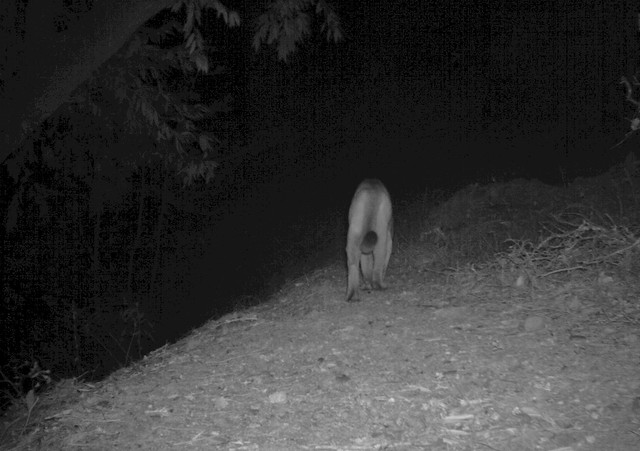
Then 9 days later, at 2 in the afternoon, the mom plopped down and watched, looked and listened for several minutes before leaving:
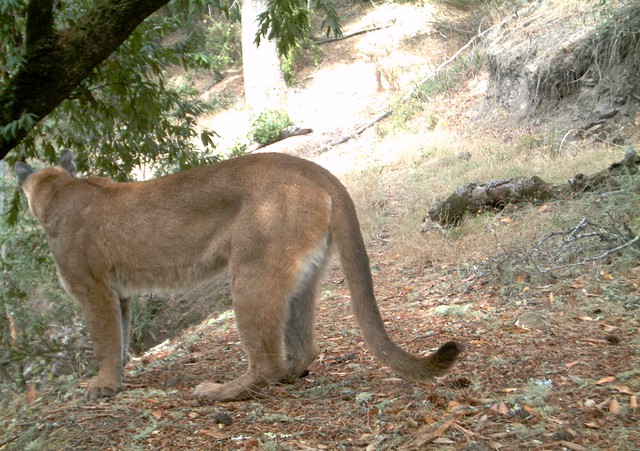
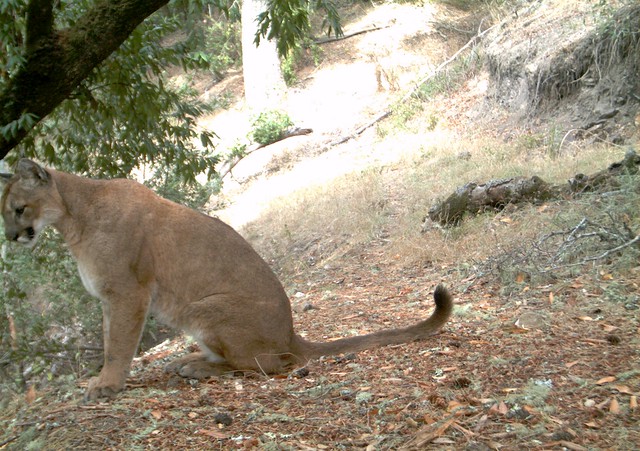
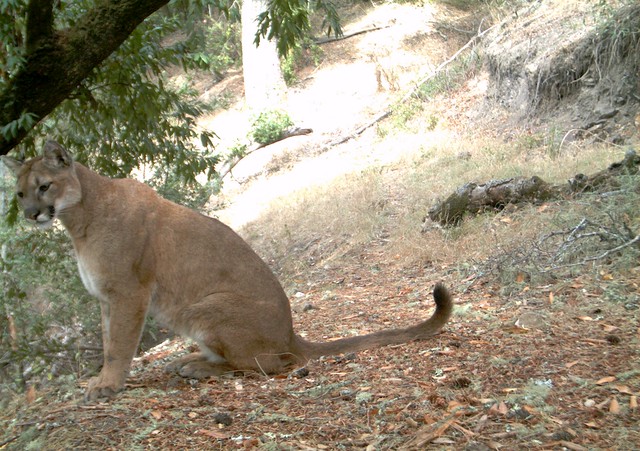
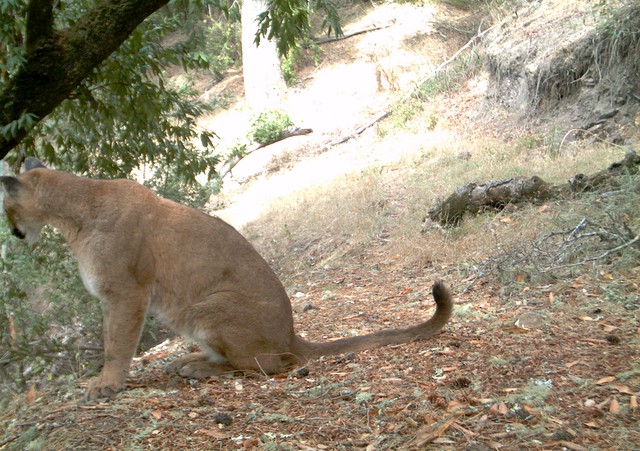
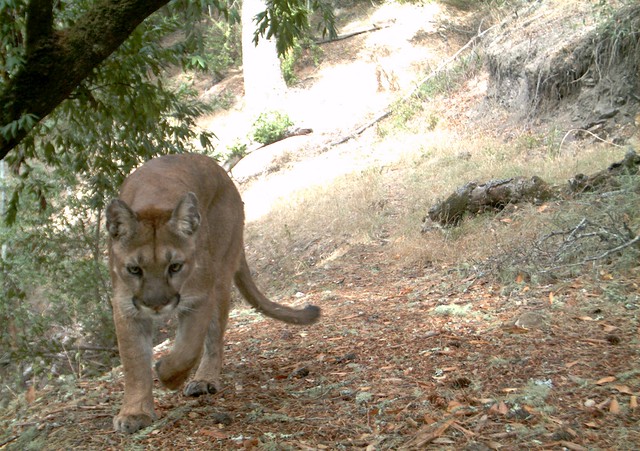
And this time the cub showed up and followed 10 minutes later:
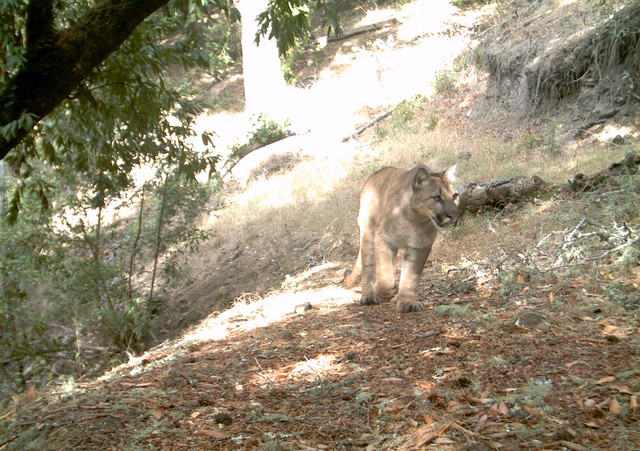
2 nights after that, the cub came and hung out in front of the camera for a full 40 photos.
Listening:
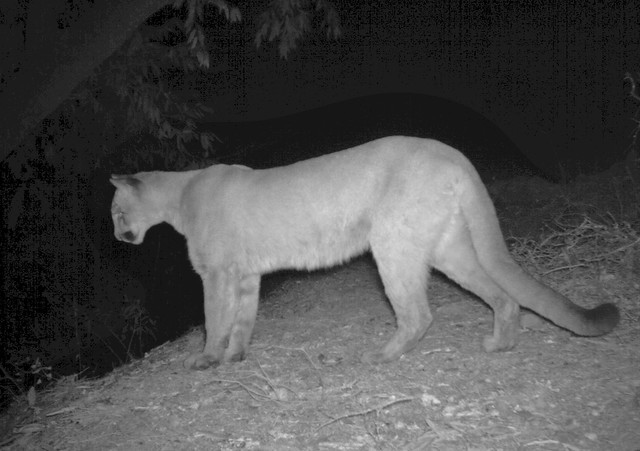
Calling:
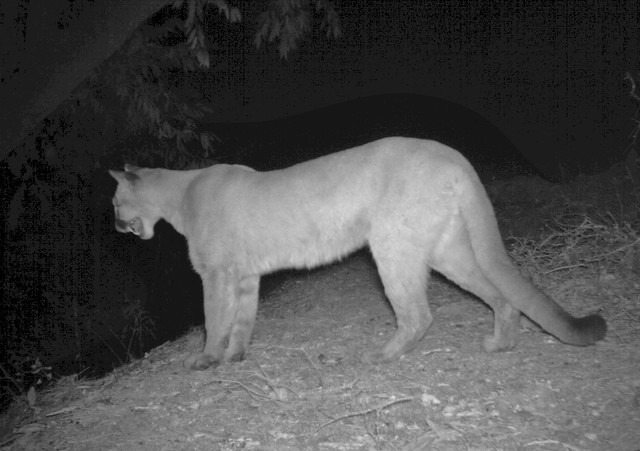
Looking around...
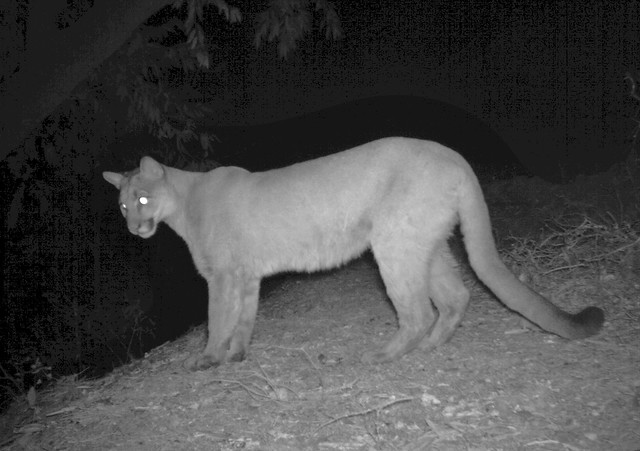
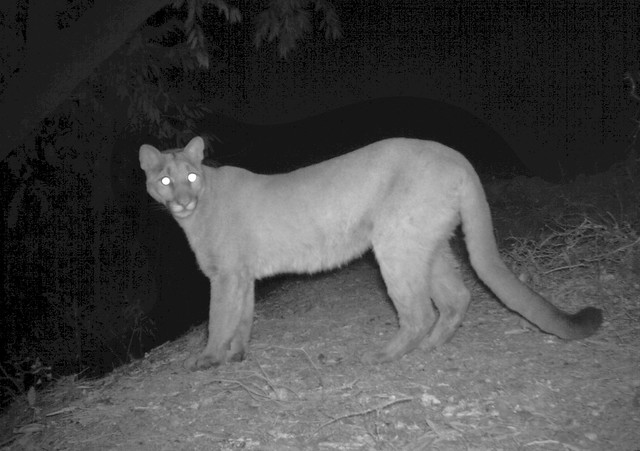
Then leaving:
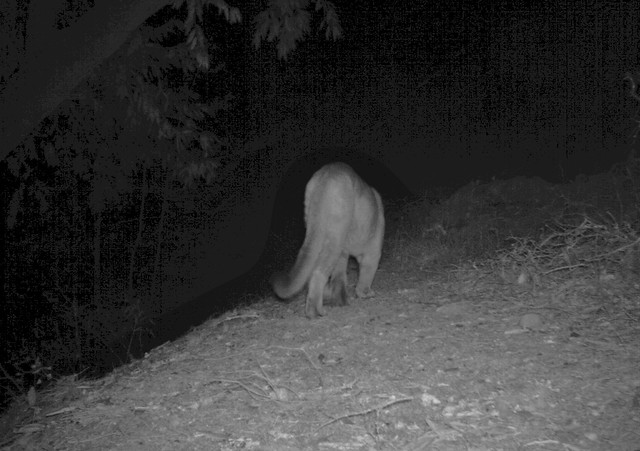
Sure doesn't seem very cubby any more, huh?
Check out that amazing tail. It's one of the best ways to recognize cougars at a distance. Just nothing else like it on the other wild animals around.
The mom wasn't caught again by the cam until the next night, and without the cub:
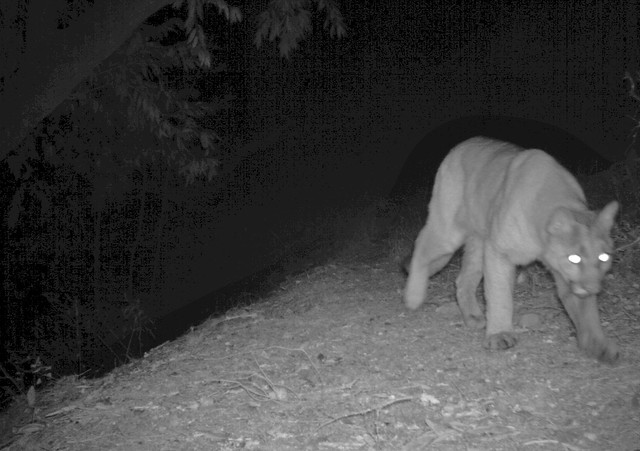
Interesting.
Here's a faux video made using all 83 photos of these 5 recent visits by the mom and cub:
I think the cub is about 16 months old now. Which makes me wonder if we aren't seeing the kick-off of dispersal, when the cub has to go find a territory of its own. With some cubs the mom has to give them a hint by avoiding them, or even chasing them away.
And dispersal is a high-risk time for young cougars. They have to wander off into unknown areas to find unclaimed land. Which is generally when they run into problems with humans and get stuck up in trees in backyards with barking dogs and Warden's rifles in their faces.
But a new law in CA, SB 132, has been passed to try and help out some of these lost lions. It creates leeway for CDFW to try and capture and save cougars when possible. But it is a tough problem, because relocation can become yet another risky dispersal event for the lion.
And not all lions are good citizens. Just like humans, lions are both a species and individuals. And sometimes individuals become problems and have to be removed from circulation. But again, just like humans, when an individual does something stupid, we shouldn't damn the whole lot.
I.e., let's not fear the beasts. Let's understand, respect and protect them. They have a role to play and we can live together just fine.
Because they really are 99.9% beauties.
==
Some Fear-reducing Factoids to remember about lions that make it much easier to suppress worry when wandering where they range:
- they have huge home ranges - 10,000+ acres - that can take them weeks to circuit, so the chances one is near where you are, are slim.
- there are only a few ranging any given area - typically a territorial male, and a female or two with any cubs they may have during that time.
- they don't want anything to do with us, and the stats really do tell that tale - on average, a cougar-human attack occurs less than once a year in all of CA. Compare that to all the other risks, such as deer-car accidents, of which there are over a million a year in the US that kill well over a hundred people. Mostly in the east, where there are no lions to eat the dumb deer.
====
References:
- Mark Elbroch & Kurt Rinehart - Behavior of North American Mammals
- E. W. Jameson, Jr., and Hans J. Peeters, UCPress - Mammals of California
- John Hunter Thomas - Flora of the Santa Cruz Mountains of California
- San Jose Mercury News - Happy New Year for wayward lions
- California Legislative Information - SB 132
- Mountain Lion Foundation - CA Senate Bill 132 - Mountain Lion Public Safety Bill
- Tracking the Furman Cougar
- Mountain Lion Foundation - Cougars at Home
- Mountain Lion Foundation - Biology and Behavior
- Felidae Conservation Fund
- UC Santa Cruz Puma Project
- California Department of Fish & Wildlife - Mountain Lion FAQs
- Wikipedia - Cougar

This is simply fabulous! I've read, re-read, and enjoyed this immensely. Fabulous work - thank you for putting it all together!
ReplyDeleteThanks. Glad to do so, Greg. They're magnificent animals and well worth it.
DeleteWhat, no collars? Was that in the Sierras? This is a great compilation. I wonder what's stage-left at the Reconyx location that captured the attention of the mom a couple times and then the cub? I once spotted a mountain lion while sitting out during a lunch break at work. The tail was unmistakable. Every couple years, we get sightings here in Pacific Grove, the last time was at McDonalds.
ReplyDeleteThere are collared cougars in the SC Mtns for the Puma Project, but the ones I've posted to-date were from the eastern Sierra. Stage left is down slope, and the lions come and go from that direction, so they might be listening to/for prey, or each other.
DeleteSuper fabulous post. Thank you SO much for sharing those images & the information.
ReplyDelete2 e.g.s that could reduce people's fear of & perhaps increase their empathy for mt. lions:
1. I chased a mt. lion adult away from my hens with a swiffer. I'm guessing it was a young adult, dispersing, and saw my BRIGHT WHITE hens as a super tasty snack. Felt kinda bad, but I just couldn't watch my frozen-with-fear hens be killed. I'm not recommending it, & I am 6' tall, but still.
2. My cousin works for county animal control (or whatever it's called) in the bay area, and was out on an assignment (deer stuck in fence?), there was a wildfire, and while he stood there out of the burning brush & trees ran a mt. lion. When it saw the people gathered there on the street, it TURNED AROUND and ran back into the wildfire. Yikes.
It's not easy being a mt. lion. ADORE your photos & the video--what a treat.
Thanks much BB. Solid testimonials. Yes, your hens may have looked like a whole lot of tasty fun. Bet your lion had a "what the?" look similar to the cougar mom above when you came out of the house all swiffer banshee on it. :)
DeleteI've never seen one in the wild and am not entirely sure I'd want to (at close range, anyway), but I'd still love to catch one in the camera trap just to know one passed through (on Mt. Tam, that is). I seem to recall an MMWD camera catching one sometime within the last year or so.
ReplyDeleteI'd bet Mt. Tam has a good share. It's a huge space that's well connected to lots of other public lands. Pretty sure Codger caught lions on his traps at Audubon Cyn Ranch, which is nearby, and well within roaming distance, too, I'd think.
DeleteNice post. Loved the faux vid. I've been hiking the SC Mts. for years... maybe 20... and have seen several killed deer, as in recently-killed, but never a lion. I figure they're nearby watching me and probably p.o.'ed that I'm ruining their mealtime. I've even tried hiking purposely at dawn/dusk to spot them with no luck.
ReplyDeleteI've never seen them in the SC Mtns either. They're kind of statistically amazing. 70-80 of them, knocking off 2,000-3,000 deer each year under the noses of near about a million people, and the sightings are pretty much as rare as ghosts.
DeleteGreat shots Ken. Now we need a Saber-tooth!
ReplyDeleteD
ah wow, great to see a Puma post from you.
ReplyDeleteI always wondered why you didn't do more post about them. Does this mean we can look forward to some more posts or will people really over react that easily to a few carnivores? Maybe I don't know your area that well but I'd expect the majority to be excited about it, with the possible exception of a few neighbouring farmers (if there are any).
Hey Henry! Yes, more will be coming. :) People do sometimes over react, but often it's our media that does it to them, by making it seem like mtn lions are uncommon, and sightings are to be feared. But that said, some of the worry can be understandable. It's not like the Santa Cruz Mtns are a wilderness area - they're encrusted with suburbia and ranches. In fact, many of the parks/preserves where the lions range are right next to housing. So - how would people down in Cape Town react if they knew there were a couple of dozen leopards hunting in Table Mtn Reserve and Signal Hill? (leopards being a better equiv to our solo, night stalking pumas).
DeleteHe he, well, but there ARE Leopards in the mountains around Cape Town :)
Deletehttp://capeleopard.org.za/research/leopard/boland
I've heard most are a little smaller than the ones found in the rest of the country, but there are some normal big ones around as well.
In general I believe the public react very positively to the Leopards roaming the mountains around here. They also seem to be very excited to find out about Caracal, etc. when seen in the city. I can't recall hearing many (if any) bad things about Leopards or other medium-large predators from non-farmers.
The only group that I know of that do pose a threat to predators are the farmers that might shoot the animals or worse put poison out when they "suddenly" find out about medium-large predators in their area. But then it's because of "economical" reasons and not fear.
I think you are correct, that one difference might be the media. In general our media reacts very positively to such matters (especially the Afrikaans media, and to a lesser extent the English media, but I don't know about the other 9 official languages). In fact a large Afrikaans newspaper recently did an article about a Caracal that was spotted in a Cape Town suburb during the day. I helped the reporter out with some info and photos for the article. The reported later let me know that he got a huge amount of positive responses about the story. People were very excited about it and shared their own crazy stories with him. Now a Caracal might not be a Mountain Lion, but they are big and ill-tempered enough to be dangerous.
Leopards around here seems to be very similar to your Mountain Lions. They are around in decent numbers, even very close to humans, but are so elusive that people hardly know they are there. In general they pose no real threat worth worrying about.
Maybe that is the other difference, over here we have much more real and pressing dangers to feed our human need for worry and fear. I believe humans have a built in need to worry and fear. If there are no "real" danger they start making things up, like alien abductions or in this case Mountain Lions. Over here being attacked by a Leopard is such a small thing compared to the violent crime, etc.
Or maybe it is the fact that we grew up with African Killer Bees and know when to stop poking the bee hive and get the hell out of there before things turn nasty :P
But I must also say that I fear the younger generation might lose what we had. They seem to be Americanising way to fast. No offence indented, I like you guys :), just saying that the "global village" comes at a price: losing local cultures, customs, etc.
Btw, this comment is getting very long and might contain too much "questionable content" for a blog comment. But I don't think I have your email address... If you would like to contact me to bash out some theories/conspiracies for whatever reason in the future then your welcome to drop me an email at henry@mywild.co.za :)
Yes, South Africa definitely has many more large animals and predators, and dangerous small ones, and thus I'd say your cultures are much better adapted to living with them. But caracals are equivalent to our bobcats and lynx, and animals that size aren't considered much of a threat by most people here. Our bears are quite large and sometimes feared, but not much, even though there are far more negative encounters between bears and people in the western US than between mtn lions and people. No - over here the mtn lion holds a special honor that's right up there with white sharks for garnering the most fear - and fascination. The invisible, perfect predator of the night. And the media just reflects that back. I look forward to the day when lion sightings here are reported for their coolness.
DeleteI agree that the globalization of the lowest common denominator of cultures, with America's Hollywood currently dominating the scene, is a worry. But the bigger cause may the the one you briefly mentioned - when people get comfortable in life, the smaller threats do get more attention, and thus need to be "solved." Because as you say, people here who live in high crime areas don't give a ____ about mtn lions.
My email address is in the right-hand column at the bottom of my bio blurb if you ever want to email me, Henry.
Some awsome daytime Lion picture
ReplyDelete